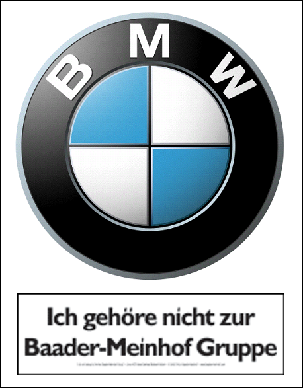Profiling Baader-Meinhof
[ by Charles Cameron — fast cars, bumper stickers — and no mention of loose women ]
.
The sentence that drives my title is this one, from How BMW Became A Terrorist Icon In The 1970s (And How It Made Them Cool) on Jalopnik:
police would set up roadblocks and stop only BMWs in an attempt to root out the gang members from the general population.
That’s profiling for you, eh?
**
Here’s a longer excerpt, so you see where this comes from — and how it turned out, at least for as the makers of BMWs:
In the early 1970s, the extreme left wing Baader-Meinhof Gang terrorized the people of West Germany with a campaign of bombings and assassinations aimed at dismantling a capitalist system they considered no better than the Third Reich.
The terrorists’ ride of choice? BMW New Class sedans and coupes, according to this documentary from historian Richard Huffman, an expert on the Baader-Meinhof Gang.
Huffman says cars became so strongly associated with the group’s acts of terror that police would set up roadblocks and stop only BMWs in an attempt to root out the gang members from the general population.
People even started saying that “Bavarian Motor Works” actually stood for “Baader-Meinhof Wagen.” Some BMW drivers even had to slap bumper stickers on their cars specifying that they weren’t terrorists.
You might expect this to have been a major PR crisis for BMW, then a small and nascent regional automaker nowhere near as prominent as it is today. But it wasn’t. That’s because the Baader-Meinhof Gang, later known as the Red Army Faction, enjoyed a surprising amount of support from people in West Germany, especially among young people and members of the left-leaning counterculture. This went a long way toward making the car seem hip in German youth culture.
Then the gang stopped being theoretical revolutionaries and actually started murdering Germans and U.S. soldiers. When the body count began to rise, public support evaporated. As for BMW, they emerged unscathed from the crisis, and started growing into the luxury giant they are today.
**
Now, what kind of analytic model would predict a series of twists and turns and hairpin bends like that?



